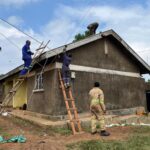Task 231
Microphysical Processes of Atmospheric Convective Systems
Principal Investigator(s):
T. Iguchi
Sponsor(s):
W-K. Tao
Last Updated:
October 26, 2012 15:25:58
Description of Problem
Cloud microphysics focuses on the physical processes on the scale from μm to cm orders in clouds. Not only it decides features of precipitation from clouds attributed to convective systems, but also it has a large impact on the overall structure of the system through heating or cooling by the water phase conversion and radiation process. Exact representation of cloud microphysics is thus an important subject of numerical studies for cloud and convective systems. We propose the development of the numerical model package to investigate a role of the cloud microphysics for the atmospheric convective systems.
Scientific Objectives and Approach
We plan to develop The Weather Research and Forecasting model coupled with Spectral Bin Microphysics for cloud (WRF-SBM), which can simulate a detailed structure of cloud microphysics in the particulate forms in idealized or real-case simulations. The development of the model is proceeded with collaborating on the project of the synthetic Global Precipitation Measurement (GPM) simulator. The coupling between the model and the Goddard Satellite Data Simulation Unit (SDSU) is aimed at providing Virtual Cloud Library (VCL) to support the development of the satellite retrieval algorithm in the GPM mission. The VCL is composed of ground validation (GV)-constrained 3D database of cloud resolving model (CRM) output and simulated GPM L1 product. The satellite retrieval algorithm can be cross-checked through a physical-based approach using the VCL as a priori database in the ground validation. We have three stages for the experiments: the Canadian CloudSAT/CALIPSO Validation Project (C3VP), Light Precipitation Validation Experiment (LPVEx) and Midlatitude Continental Convective Clouds Experiment (MC3E).
Accomplishments
During this term, we updated the cloud microphysical package of the WRF-SBM by using a new module that includes explicit melting and snow-riming processes. The updated model was employed for the simulations of the snowfall events during the C3VP, mixed-phase precipitation events during the LPVEx campaign and continental convective precipitation events upon the MC3E campaign. The results of the simulations were archived in the VCL database of the preliminary validation stage and analyzed by comparing with observational data for the validation. In the analysis for the C3VP case, the WRF-SBM simulation has reproduced the distinct microphysical structures of the events characterized by presence or absence of riming process through an interaction with supercooled water. Additional tests are performed using different planetary boundary layer (PBL) schemes and/or special microphysics treatments to investigate a sensitivity of the properties of the convective boundary layer (CBL) clouds to them. The tests reveal that PBL process has an influence not only on the macrostructure of the CBL clouds and precipitation but also on the cloud microphysical structure with riming process through changes in moisture supply and resultant supercooled water.
The update of WRF-SBM made possible to represent a radar blight band associated with a melting layer. However in the LPVEx analysis, the WRF-SBM tends to overestimate the thickness of the bright bands as compared with the ground-based radar measurement. A modification for the calculation of melting process is now being developed. In the MC3E analysis, the WRF-SBM simulation successfully reproduced a classification of precipitation type observed in the ground-based instrument measurement (Figure). The surface precipitation sampled by the ground in-situ instrument was divided into two distinct types: relatively large particle size with a proportionate increase in rain rate (convective) and small particle size less correlated with rain rate (stratiform). The corresponding derivative simulated using the WRF-SBM result shows the similar characteristics, though the profile tends to be more scattered. This classification has also applied to the correlation plots between surface rain number concentration and rain rate derived from both the measurement and simulation.
Other Publications and Conferences
Iguchi T., T. Matsui, W.-K. Tao, 2011: Sensitivity experiments of condensation nuclei effect on cloud microphysics using WRF-SBM for MC3E case., American Geophysical Union Fall Meeting, San Francisco, CA, December 5-9, 2011.
Task Figures
| Fig. 1 – Scatter plots between surface rain rate and bulk effective rain radius, comparing between the ground-based in-situ measurement (Parsivel) and the WRF-SBM model simulation. |






